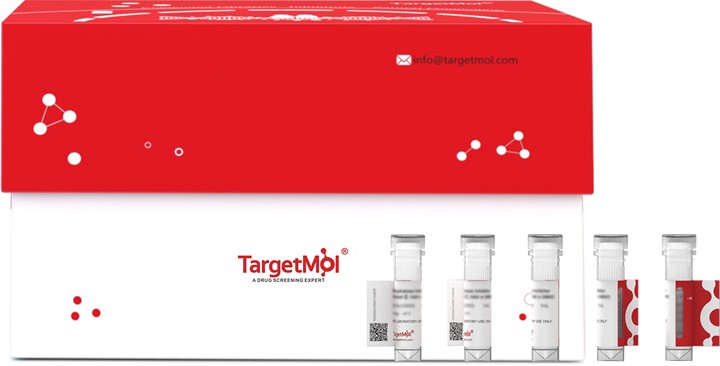 Your shopping cart is currently empty
Your shopping cart is currently empty
Carboxypeptidase B2 Protein, Human, Recombinant (His)
Carboxypeptidase B2 (CPB2) is a secreted enzyme that belongs to the peptidase M14 family. CPB2 is synthesized by the liver and circulates in the plasma as a plasminogen-bound zymogen by the liver and circulates in the plasma as a plasminogen-bound zymogen. CPB2 cleaves C-terminal arginine or lysine residues from biologically active peptides, such as kinins or anaphylatoxins, in the circulation regulating their activities. CPB2 also down-regulates fibrinolysis by removing C-terminal lysine residues from fibrin that has already been partially degraded by plasmin. CPB2 exhibits carboxypeptidase activity when it is activated by proteolysis at residue Arg92 of the thrombin/thrombomodulin complex. Activated CPB2 reduces fibrinolysis by removing the fibrin C-terminal residues that are important for the binding and activation of plasminogen.

Carboxypeptidase B2 Protein, Human, Recombinant (His)
| Pack Size | Price | USA Warehouse | Global Warehouse | Quantity |
|---|---|---|---|---|
| 5 μg | $80 | - | In Stock | |
| 10 μg | $129 | - | In Stock | |
| 20 μg | $198 | - | In Stock | |
| 50 μg | $390 | - | In Stock | |
| 100 μg | $626 | - | In Stock | |
| 200 μg | $987 | 7-10 days | 7-10 days | |
| 500 μg | $1,900 | 7-10 days | 7-10 days | |
| 1 mg | $2,730 | 7-10 days | 7-10 days |
Product Information
| Biological Activity | Activity has not been tested. It is theoretically active, but we cannot guarantee it. If you require protein activity, we recommend choosing the eukaryotic expression version first. |
| Description | Carboxypeptidase B2 (CPB2) is a secreted enzyme that belongs to the peptidase M14 family. CPB2 is synthesized by the liver and circulates in the plasma as a plasminogen-bound zymogen by the liver and circulates in the plasma as a plasminogen-bound zymogen. CPB2 cleaves C-terminal arginine or lysine residues from biologically active peptides, such as kinins or anaphylatoxins, in the circulation regulating their activities. CPB2 also down-regulates fibrinolysis by removing C-terminal lysine residues from fibrin that has already been partially degraded by plasmin. CPB2 exhibits carboxypeptidase activity when it is activated by proteolysis at residue Arg92 of the thrombin/thrombomodulin complex. Activated CPB2 reduces fibrinolysis by removing the fibrin C-terminal residues that are important for the binding and activation of plasminogen. |
| Species | Human |
| Expression System | HEK293 Cells |
| Tag | C-6xHis |
| Accession Number | Q96IY4-1 |
| Synonyms | Thrombin-Activable Fibrinolysis Inhibitor,TAFI,Plasma Carboxypeptidase B,pCPB,CPU,CPB2,Carboxypeptidase U,Carboxypeptidase B2 |
| Amino Acid | Phe23-Val423 |
| Construction | Phe23-Val423 |
| Protein Purity | Greater than 95% as determined by reducing SDS-PAGE. Greater than 95% as determined by SEC-HPLC. |
| Molecular Weight | 55-65 KDa (reducing condition) |
| Endotoxin | < 0.1 ng/µg (1 EU/µg) as determined by LAL test. |
| Formulation | Supplied as a 0.2 μm filtered solution of 20 mM Tris-HCl, 150 mM NaCl, 1 mM ZnCl<sub>2</sub>, 10% Glycerol, pH8.0. |
| Stability & Storage | Lyophilized powders can be stably stored for over 12 months, while liquid products can be stored for 6-12 months at -80°C. For reconstituted protein solutions, the solution can be stored at -20°C to -80°C for at least 3 months. Please avoid multiple freeze-thaw cycles and store products in aliquots. |
| Shipping | Shipping with blue ice. |
| Research Background | Carboxypeptidase B2 (CPB2) is a secreted enzyme that belongs to the peptidase M14 family. CPB2 is synthesized by the liver and circulates in the plasma as a plasminogen-bound zymogen by the liver and circulates in the plasma as a plasminogen-bound zymogen. CPB2 cleaves C-terminal arginine or lysine residues from biologically active peptides, such as kinins or anaphylatoxins, in the circulation regulating their activities. CPB2 also down-regulates fibrinolysis by removing C-terminal lysine residues from fibrin that has already been partially degraded by plasmin. CPB2 exhibits carboxypeptidase activity when it is activated by proteolysis at residue Arg92 of the thrombin/thrombomodulin complex. Activated CPB2 reduces fibrinolysis by removing the fibrin C-terminal residues that are important for the binding and activation of plasminogen. |
Dose Conversion
Calculator
Tech Support
| Size | Quantity | Unit Price | Amount | Operation |
|---|

Copyright © 2015-2025 TargetMol Chemicals Inc. All Rights Reserved.



